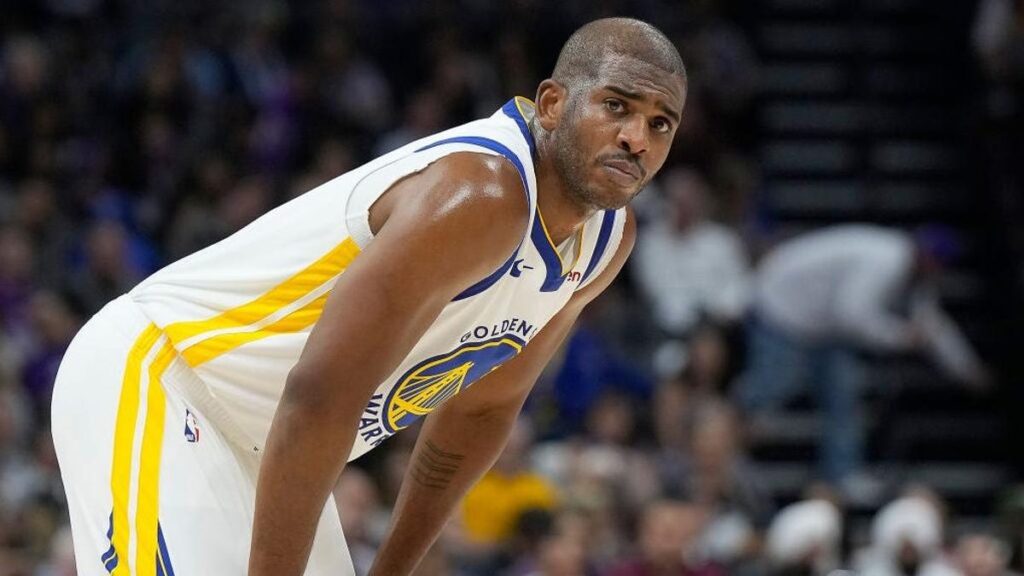Chris Paul’s 18-year run as a starting point guard finally came to an end on Sunday. The 1,365 consecutive games Paul started to begin his career including the playoffs, are the most consecutive starts for a player prior to coming off the bench for the first time. After nearly two decades of being the main course, or at least the appetizer, in every offensive dish he’s ever served, he’s an aged wine off the bench cellar. Most first-ballot Hall of Famers would rather retire than labor on as a bench body. However, Chris Paul lingers on like a spirit with unfinished business. Paul has never tasted champagne during a title celebration.
When the Warriors dumped Jordan Poole on the Wizards and set their tractor beams on the 38-year-old Paul, it felt like a team finally giving into their gray instead of buying Rogaine, and clinging to 24-year-olds who had nothing in common with them.
All offseason, Steve Kerr seemed to toy with the idea of starting Paul in a three-guard small-ball offense. That was just a ruse to protect Paul’s ego. It’s bad enough he had to join the team that beat him so often, but he was facing the possibility of sitting behind the MVP who displaced him as the league’s preeminent point guard. But at this point in his career, Paul should have given up on minor grievances in pursuit of a common goal. He’s accomplished everything he’s needed to. This is not a demotion. It’s his basketball afterlife. Everyone doesn’t get one. Some guys announce their own time of death when interest dries up.
That CP3’s run came on the same night as the 20th anniversary of LeBron James’ NBA debut against the Sacramento Kings shouldn’t be lost on us. Paul hasn’t benefited from the physical advantage James was born with. Standing just 6 feet tall, he’s three inches shorter than Steph Curry. Two weeks after James dropped the hammer on Sacramento, Paul was introduced to the nation as a Wake Forest point guard. By the time he was drafted in 2005, Sebastian Telfair was still a rising young rival. Deron Williams retired a decade ago.
However, the signs of Paul’s decline snuck up on everyone. Two years ago, he was the impetus behind Phoenix’s Finals run. His knees started getting creakier, his ligaments lost their elasticity, and his hamstring injuries were occurring more frequently. He’d bounced back before in Oklahoma City after the hoops world thought he’d lost a step, but at his age, this was different. After it became apparent that the Phoenix Suns were planning to move on from Paul this summer, a slew of franchises with starting point guard concerns bounced around as soft landing spots.
However, I suggested that his next stop should be as the conductor off the bench for a contender. By their age-38 seasons, even Hall of Fame point guards see their productivity tumble off a cliff. Steve Nash went from being the oldest player to lead the league in assists to averaging fewer than seven dimes and 13 points a night. Jason Kidd’s assist-to-turnover ratio was in the basement. John Stockton between the ages of 38 and 40 is the only outlier to resemble a league-average starter into the twilight of his 30s.
At Paul’s current pace of nine dimes a night, he’d create a new benchmark for 38-and-older distributors, but his scoring efficiency has fallen off a cliff as he’s struggled to separate from defenders. It’s still early, but Paul’s .343 shooting percentage and .411 true shooting percentage would be among the worst ever. The hope is that Green’s return to the lineup will enable Golden State to slash Paul’s court time from the 33 minutes a night he was playing to start the 2023 campaign.
Fortunately, subterranean second units are where the more ordinary athletes reside beneath the metropolitans where starters stalk the floor. There, Paul gets to be king of the sewers, spending more time manipulating lineups featuring fellow senior citizens who used to be starters, bench lifers, and basketball’s next generation in their infancy, which should mask his athletic deficiencies better. Soon after Paul’s stint in Golden State began, there was a fixation with how well his ball-dominant style of play would mesh with Steph Curry, or how he’d enhance his game when they were on the floor together.
Paul has been the ultimate pick-and-roll CEO in the NBA for two decades while Golden State prefers to whip the ball around. Paul’s actual value is in getting the gears moving when Dario Saric, Jonathan Kumingas, Gary Payton Jr., Moses Moody, and Wiggins share the floor.
On the second unit, Jordan Poole would get control of the wheel, and steer the offense like his pupils were dilated after a rave. Steve Kerr often had to play traffic cop and pull him aside. He was turnover-prone, making highlight reel plays, and channeling his inner Monta Ellis. Paul is the new Iguodala. His numbers won’t always reflect the calm he provides the second team. However, basketball IQ, savvy expertise, and court vision could only keep him as a viable starting floor general for so long. But he’s found a new role to thrive in. The extra $60 million Paul is owed on his contract over the next two years probably helps him sleep at night during the transition.
Follow DJ Dunson on X: @cerebralsportex




